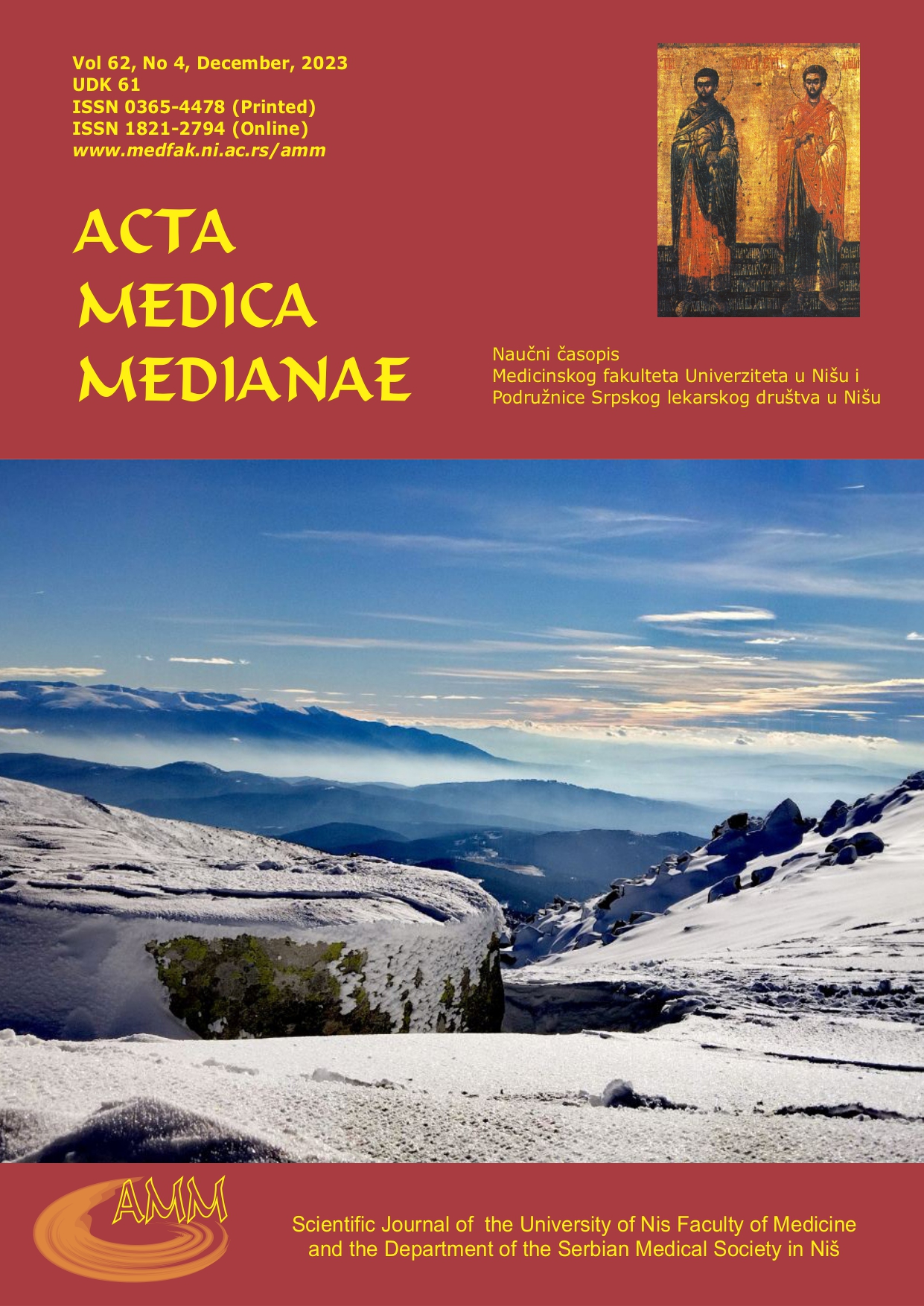ALATI ZA PROCENU KRVARENJA
Sažetak
Alati za procenu krvarenja (engl. blood assessment tool − BATs) predstavljaju sisteme bodovanja za krvarenja koji se koriste za skrining i kvantitativnu procenu blagih poremećaja krvarenja. Sastoje se od standardizovanog upitnika i sistema bodovanja koji se upotrebljava za računanje konačnog zbira bodova. U ovom preglednom članku predstavljeni su alati za procenu krvarenja koji se koriste u oblasti hematologije.
Prvi alati bili su dizajnirani radi razlikovanja bolesnika sa Fon Vilebrandovom bolešću od zdravih osoba. Kasnije modifikacije originalnog Vičenza alata razvijene su kako bi se poboljšale njegova specifičnost, preciznost i fleksibilnost i kako bi se skratilo vreme potrebno za popunjavanje upitnika. Najznačajnija od ovih modifikacija jeste alat Internacionalnog društva za trombozu i hemostazu (ISTH-BAT), takođe validiran za upotrebu kod hemofilije i urođenih bolesti trombocita. ISTH-BAT zbir > 6 kod odraslih žena, > 4 kod odraslih muškaraca i > 3 kod dece smatra se abnomalnim nalazom.
Prvi alat za imunološku trombocitopeniju (engl. immune thrombocytopenia− ITP) razvila je Svetska zdravstvena organizacija (SZO). Međutim, nedavno je Internacionalna radna grupa (engl. International Working Group−IWG) za ITP razvila ITP-BAT. Radna grupa definiše teško / klinički relevantno krvarenje kao ITP-BAT SMOG index: S > 2 i/ili M > 1 i/ili O > 1. Modifikovanjem ITP-BAT tokom 2016. godine grupa kineskih eksperata razvila je ITP-2016. Vrednosti ITP-2016 zbira > 5 odgovaraju teškoj imunološkoj trombocitopeniji.
Na nivou primarne zdravstvene zaštite alati za procenu krvarenja predstavljaju korisne skrining alate za otkrivanje bolesnika sa patološkim krvarenjima, koji zahtevaju sprovođenje dopunskih hematoloških pretraga.
Reference
Balduini CL, Cattaneo M, Fabris F, Gresele P, Iolascon A, Pulcinelli FM, et al. Inherited thrombocytopenias: a proposed diagnostic algorithm from the Italian Gruppo di Studio delle Piastrine. Haematologica 2003; 88(5): (582-592). [PubMed]
Benson G, Auerswald G, Dolan G, Duffy A, Hermans C, Ljung R et al. Diagnosis and care of patients with mild haemophilia: practical recommendations for clinical management. Blood Transfus 2018; 16(6): 535-544. [CrossRef][PubMed]
Boender J, Kruip MJHA, Leebeek FWG. A diagnostic approach to mild bleeding disorders. J Thromb Haemost 2016; 14(8): 1507-1516. [CrossRef][PubMed]
Borhany M, Fatima N, Abid M, Shamsi T, Othman M. Application of the ISTH bleeding score in hemophilia. Transfus Apher Sci 2018; 57(4): (556-560). [PubMed]
Duga S, Salomon O. Factor XI Deficiency. Semin Thromb Hemost 2009; 35(4): 416-425. [CrossRef][PubMed]
Elbatarny M, Mollah S, Grabell J, Bae S, Deforest M, Tuttle A et al. Normal range of bleeding scores for the ISTH-BAT: adult and pediatric data from the merging project. Haemophilia 2014; 20(6); 831-835. [CrossRef][PubMed]
Elbaz C, Sholzberg M. An illustrated review of bleeding assessment tools and common coagulation tests. Res Pract Thromb Haemost 2020; 4(5): 761-773. [CrossRef][PubMed]
Gresele P, Orsini S, Noris P, Falcinelli E, Alessi MC, Bury L et al.. Validation of the ISTH/SSC bleeding assessment tool for inherited platelet disorders: A communication from the Platelet Physiology SSC. J Thromb Haemost 2020; 18(3): (732-739). [CrossRef][PubMed]
Gresele P. Diagnosis of inherited platelet function disorders: guidance from the SSC of the ISTH. J Thromb Haemost 2015; 13(2): (314-322). [CrossRef][PubMed]
Huang J, Zeng B, Li X, Huang M, Zhan R. Comparative Study of the Clinical Application of 2 Bleeding Grading Systems for Pregnant Women With Immune Thrombocytopenia. Clin Appl Thromb Hemost 2020; 26: (1-4). [CrossRef][PubMed]
James PD, Mahlangu J, Bidlingmaier C, Mingot-Castellano ME, Chitlur M, Fogarty PF et al. Evaluation of the utility of the ISTH-BAT in haemophilia carriers: a multinational study. Haemophilia 2016; 22(6): (912-918). [CrossRef][PubMed]
Kistanguri G, McCrae KR. Immune Thrombocytopenia. Hematol Oncol Clin North Am (serial online) 2013; 27(3): (495-520). [CrossRef][PubMed]
Kohli R, Chaturvedi S. Epidemiology and Clinical Manifestations of Immune Thrombocytopenia. Hamostaseologie 2019; 39: (3)(238-249). [CrossRef][PubMed]
Li S, Fang Y, Li L, Lee A, Poon M, Zhao Y et al. Bleeding assessment in haemophilia carriers-High rates of bleeding after surgical abortion and intrauterine device placement: A multicentre study in China. Haemophilia 2020; 26(1): (122-128). [CrossRef][PubMed]
Makris M, Hermans C. The 2021 von Willebrand disease guidelines: Clarity and controversy. Haemophilia 2022; 28(1); 1-3. [CrossRef][PubMed]
Miller AB, Hoogstraten B, Staquet M, Winkler A. Reporting results of cancer treatment. Cancer 1981; 47(1): (207-214). [CrossRef][PubMed]
Nichols WL, Hultin MB, James AH, Manco-Johnson MJ, Montgomery RR, Ortel TL et al. von Willebrand disease (VWD): evidence-based diagnosis and management guidelines, the National Heart, Lung, and Blood Institute (NHLBI) Expert Panel report (USA). Haemophilia 2008; 14(2): 171-232. [CrossRef][PubMed]
Pai M. Acquired Hemophilia A. Hematol Oncol Clin North Am (serial online) 2021; 35(6): (1131-1142). [CrossRef][PubMed]
Rajić N. Von Willebrand disease - detection, diagnostics and treatment. Med Pregl 2022; 75(1): 147-151. [CrossRef]
Rodeghiero F, Castaman G, Dini E. Epidemiological Investigation of the Prevalence of von Willebrand΄s disease. Blood 1987; 69(2): 454-459. [CrossRef][PubMed]
Rodeghiero F, Michel M, Gernsheimer T, Ruggeri M, Blanchette V, Bussel JB et al. Standardization of bleeding assessment in immune thrombocytopenia: report from the International Working Group. Blood 2013; 121(14): (2596-2606). [CrossRef][PubMed]
Rodeghiero F, Tosetto A, Abshire T, Arnold DM, Coller B, James P et al.. ISTH/SSC bleeding assessment tool: a standardized questionnaire and a proposal for a new bleeding score for inherited bleeding disorders. J Thromb Haemost 2010; 8(9): 2063-2065. [CrossRef][PubMed]
Sang Y, Roest M, de Laat B, de Groot PG, Huskens D. Interplay between platelets and coagulation. Blood Rev 2021; 46: 100733. [CrossRef][PubMed]
Sholzberg M. Haemophilia commentary: The utility of BATs. Haemophilia 2018; 24(4): 522-524. [CrossRef][PubMed]
Thrombosis and Hemostasis Group, Chinese Society of Hematology, Chinese Medical Association. Chinese guideline on the diagnosis and management of adult primary immune thrombocytopenia (version 2020). Zhonghua Xue Ye Xue Za Zhi 2020; 41(8): (617-623). [CrossRef][PubMed]
Vučić M, Lilić B. Clinical significance of bleeding scoring systems. Med Pregl 2022; 75(1): 133-142. [CrossRef]
Xiao S, Liu Q, Hou M. Comparative study between two bleeding grading systems of primary immune thrombocytopenia. Zhonghua Xue Ye Xue Za Zhi 2017; 38(5): (394-398). [CrossRef][PubMed]

